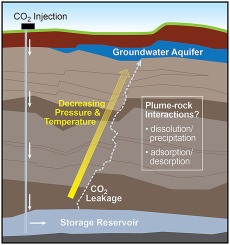Chemosphere ( IF 8.1 ) Pub Date : 2018-01-04 , DOI: 10.1016/j.chemosphere.2017.12.199 Amanda R. Lawter , Nikolla P. Qafoku , R. Matthew Asmussen , Ravi K. Kukkadapu , Odeta Qafoku , Diana H. Bacon , Christopher F. Brown

|
Despite the numerous studies on changes within the reservoir following CO2 injection and the effects of CO2 release into overlying aquifers, little or no literature is available on the effect of CO2 release on rock between the storage reservoirs and subsurface. This is important, because the interactions that occur in this zone between the CO2 storage reservoir and the subsurface may have a significant impact on risk analysis for CO2 storage projects. To address this knowledge gap, relevant rock materials, temperatures and pressures were used to study mineralogical and elemental changes in this intermediate zone. After rocks reacted with CO2-acidified 0.01 M NaCl, liquid analysis showed an increase of major elements (e.g., Ca and Mg) and variable concentrations of potential contaminants (e.g., Sr and Ba); lower aqueous concentrations of these elements were observed in N2 control experiments, likely due to differences in pH between the CO2 and N2 experiments. In experiments with As/Cd and/or organic spikes, representing potential contaminants in the CO2 plume originating in the storage reservoir, most or all of these contaminants were removed from the aqueous phase. SEM and Mössbauer spectroscopy results showed the formation of new minerals and Fe oxides in some CO2-reacted samples, indicating potential for contaminant removal through mineral incorporation or adsorption onto Fe oxides. These experiments show the interactions between the CO2-laden plume and the rock between storage reservoirs and overlying aquifers have the potential to affect the level of risk to overlying groundwater, and should be considered during site selection and risk evaluation.
中文翻译:

在潜在的CO 2泄漏过程中,CO 2储集层和上覆含水层之间的碳酸盐岩中的元素动员和固定化
尽管对注入CO 2后储层内的变化以及CO 2释放到上覆含水层中的影响进行了大量研究,但关于CO 2释放对储层和地下储层之间岩石的影响的文献很少或没有。这很重要,因为在此区域中发生的CO 2储存储层与地下之间的相互作用可能会对CO 2储存项目的风险分析产生重大影响。为了解决这一知识鸿沟,使用了相关的岩石材料,温度和压力来研究该中间带的矿物学和元素变化。岩石与CO 2反应后-酸化0.01 M NaCl,液体分析显示主要元素(例如Ca和Mg)增加,潜在污染物(例如Sr和Ba)浓度变化;在N 2对照实验中观察到这些元素的水含量较低,这很可能是由于CO 2和N 2实验之间的pH值差异所致。在用As / Cd和/或有机尖峰表示来自存储库的CO 2羽流中的潜在污染物的实验中,大多数或所有这些污染物已从水相中去除。SEM和Mössbauer光谱结果表明在某些CO 2中形成了新的矿物和Fe氧化物-反应的样品,表明可能通过矿物掺入或吸附到氧化铁上而去除污染物。这些实验表明,充满CO 2的羽流与储层和上覆含水层之间的岩石之间的相互作用可能会影响上覆地下水的风险水平,因此在选址和风险评估时应予以考虑。











































 京公网安备 11010802027423号
京公网安备 11010802027423号